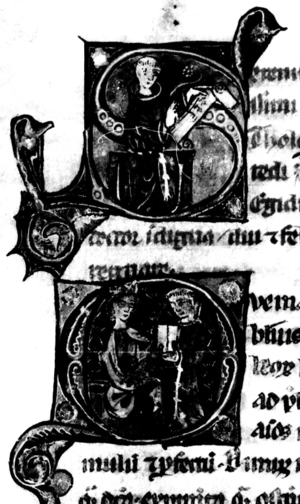Juan Gil de Zamora facts for kids

Juan Gil de Zamora (born around 1240 – died around 1320) was a smart and busy writer from Castile, a kingdom in old Spain. He was a Franciscan friar, which is like a monk who lives in a community and helps people. Juan was part of the writing group around King Alfonso X, a very important king who loved learning. Juan wrote about many different things, including stories of saints, history, music, nature, poems, and speeches for church.
Life of Juan Gil de Zamora
Juan was born in a city called Zamora. We don't know the exact year he was born, but it was probably around 1240.
He joined the Franciscan order around 1269 or 1270. He studied for a short time at the University of Salamanca. Then, he spent at least four years studying at the University of Paris. There, he learned from famous thinkers like Bonaventure and Godfrey of Fontaines. By 1276 or 1277, he earned a special degree in theology from Paris. After his studies, he returned to Zamora. He became a teacher of theology and a leader in the Franciscan community there.
Around this time, Juan started working for King Alfonso X. The king trusted him to teach his son, Sancho. Juan even compared his relationship with Sancho to that of the famous philosopher Aristotle teaching Alexander the Great. Juan was with Prince Sancho in 1278 when Sancho signed an important document for the church and city of Zamora. Around the year 1300, Juan became a main leader for the Franciscans in the area of Santiago de Compostela. He passed away after 1318, probably around 1320. We don't know the exact date.
Works of Juan Gil de Zamora
Juan was a very busy writer. He wrote many books in Latin, the language of scholars back then. He helped create important works at King Alfonso X's court. These included the Primera Crónica General, which was a big history book, and the Cantigas de Santa María, a collection of songs about the Virgin Mary. Juan was also one of the first Franciscan poets from Spain.
Fifteen of his works are still around today, at least in parts:
- Prosologion seu tractatus de accentu et de dubilibus Bibliae (written between 1274 and 1278)
- This book was about grammar. It taught about spelling, word origins, and how words sound. It also helped people understand difficult parts of the Bible, including how to pronounce names and use punctuation.
- Historia naturalis (written between 1275 and 1295)
- This was a huge encyclopedia about the natural world. It was planned to have 23 books, one for each letter of the Latin alphabet. Only the first part (Book A and the start of Book B) still exists. Juan wrote this book to teach moral lessons and help people who wrote sermons.
- Archiuium seu armarium scripturarum (around 1278)
- This was another encyclopedia with 23 books. It covered nature, history, and religious topics. Only small pieces of it have survived.
- Dictaminis epithalamium (before 1282)
- This was a guide for writing letters and official documents. Half of the book was filled with examples to show people how to write correctly.
- Liber de preconiis Hispaniae (started 1278, finished 1282)
- This was a special encyclopedia that praised Spain. It included historical and geographical information. Juan dedicated it to Prince Sancho. It was like a "mirror for princes," a book that taught a young ruler how to be a good leader.
- Liber de preconiis ciuitatis Numantinae (1282)
- This book was a tribute to Juan's hometown, Zamora. He believed Zamora was connected to the ancient city of Numantia. It was written to entertain Prince Sancho.
- Liber illustrium personarum (around 1282)
- This was an encyclopedia about famous people in history. Only parts of it remain, but it includes a full section on the kings of Spain.
- Officium almifluae Uirginis (before 1284)
- This was a long poem (316 lines) written for church services about Mary, mother of Jesus.
- Sermones sanctorum (before 1289)
- This was a collection of 70 sermons, which are speeches given in church.
- Breuiloquium de uitiis et uirtutibus (before 1289)
- This book contained 15 sermons about different bad habits (vices) and good qualities (virtues).
- Liber contra uenena et animalia uenenosa (written between 1289 and 1295)
- This was a medical book about poisons from plants, animals, and minerals. It was organized like a dictionary, from A to Z.
- Ars musicae (either in the 1250s or between 1296 and 1304)
- This book was about music. It talked about where music came from and how it makes people feel. Juan believed that out of all musical instruments, only the organ was right for church services.
- Liber de Ihesu et Maria (1300)
- This work was originally one book with essays about the life of Jesus and Mary. Later, the two parts were often copied and read separately.
- De proprietatibus animalium
- This was an encyclopedia about animals. Only the first part (Book A) has survived.
- Legendae sanctorum et festiuitatum aliarum de quibus ecclesia sollempnizat
- This was a collection of 86 stories about saints' lives, arranged in alphabetical order. It was meant for other Franciscans.
Many other works are mentioned as being written by Juan, but they might be parts of his known encyclopedias or have different titles. Some scholars also think Juan wrote the Lucidario, another encyclopedia connected to King Sancho IV's court.
See also
 In Spanish: Juan Gil de Zamora para niños
In Spanish: Juan Gil de Zamora para niños

